Every week, I want to break the defense down in a manner that helps us quantify just how well it did as a group and figure out what it is trying to do strategically (and more importantly, how well it is doing it).
Following the offense and its tactics is much easier for us than following the defense. From a coaching standpoint, many will tell you that installing and running an offense is far more time-consuming because defense requires reactions, and once you are prepared from that perspective, it is simply a matter of getting the task and completing it. Offenses set the agenda and defenses must match up.
But, for media or fans, because offense is generally proactive and defense is mostly reactive, we have a harder time getting into the mind of defensive coordinator Rod Marinelli, as he is trying to deal with what the opponent is asking of his defense. And from that standpoint, we do know plenty of things about Marinelli and the Cowboys defense:
We know they value playing aggressively conservative: That means doing as much as you can while not deploying your troops in an unsafe manner. Position everyone in rather conservative spaces (four-man rushes, zone defenses), then ask those players to play as aggressively as they can from that spot.
We know they prioritize not getting beaten on big plays: Part of not blitzing much or forcing the action means you have more players behind the deepest threat. They allowed 51 "explosives" last year. Explosives are 20-yard plays, and while Dallas trailed elite defenses in Denver and Minnesota by a handful, that mark ranked sixth in the NFL. The NFL average is 60 explosives conceded, and several teams gave up 70. But the Cowboys, with their careful defenses, allowed 51. If you are going to play for Marinelli, you can't get beat big.
We know the organization is of the belief that the lion's share of its resources should go to an overpowering offense and the defense will have to be built much more on quantity than quality: The Cowboys spend about 33 percent of their total salary cap resources on the defense. Only three defenders make more than $2.6 million this season -- Tyrone Crawford, Sean Lee and Orlando Scandrick. Their entire defensive unit is paid next to nothing these days, so they want the defense to fight their tails off -- but not win games individually very often.
We know takeaways are never easy for this group: In 2015, the Cowboys had the fewest takeaways in the NFL with 11 (tied the all-time record), so in 2016, when it jumped to 20 (tied for 19th), people were happier, but the Cowboys were still below the NFL average of 22. With 31 takeaways in their past 32 regular season games, it is difficult to say they are very good at getting the ball.
Finally, we know that when searching for players, they search and prioritize motors over measureables: If Marinelli has taught us anything during his time, it is that he wants his players to be going full speed no matter where they are on the field. No loafing! He is a big believer in effort before anything else, and when they are searching for another member of this defense, know that they are looking for the guy who never stops. It's great that you run fast or jump high, but if you walk too much when you think the ball is not in your area, Rod doesn't want you.
OK, so those are basically the pillar beliefs. Now let's look at other attributes and some numbers to back them up.
Blitz rates
Every week when we chart the Cowboys, we note how many rushers they send and how often they send them -- sometimes there is a delayed rusher, so the numbers we chart and Football Outsiders and ESPN info slightly disagree, but here are our findings from last season on a week-by-week basis:
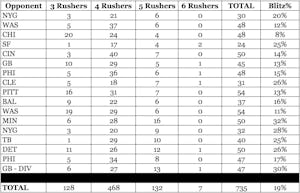
As you can see, about nine times per game, the Cowboys will send more than four. Of course, about eight times per game, they will send less than four. So, net blitzing? Almost nothing. They are one of the least-blitzing teams in the NFL and are actually dead last on big blitzes (sending six-plus). Now, when they do blitz, they like to send a slot corner more so than a linebacker. So, keep that in mind (although I think Jaylon Smith might change that). They don't like blitzing, but when they do, it is from the slot.
Blitz rate vs. the NFL
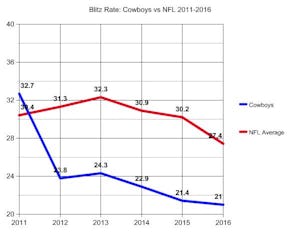
According to Football Outsiders, the Cowboys have been below the league average by a healthy margin in the past five seasons. In 2011, Rob Ryan decided to crank it up (to generally mixed results), but since then -- especially back in the 4-3 era -- they have decided to flood the secondary with zone defenses or 2-deep man coverages to "keep everything in front of them." Somehow, since Marinelli took over, they have actually rushed less and less every year. But we notice the league, in general, is doing the same.
Personnel usage
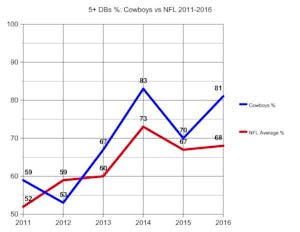
If nothing else, we have to get this message out there. The Cowboys' base defense is not a 4-3. On 81 percent of all defensive snaps last year, they ran a 4-2 or a 3-3 because they had at least five defensive backs in the game. Sometimes, they had six! This is the direction the NFL is going, but the Cowboys are playing five defensive backs almost all the time. So who is the Cowboys' SAM linebacker? Well, since he plays so rarely, it doesn't matter as much as who the Cowboys' fifth defensive back is going to be. That guy is going to play 400 percent more than the SAM linebacker.
Since the NFL has moved to having three wide receivers on the field at most times, it stands to reason that the league also has moved toward having five defensive backs ready to match up.
Coverages
We are often asked which coverages the Cowboys favor the most. Well, they mix from zone to man quite a bit. Their zones are definitely Cover 3, with a little Cover 2 mixed in. But they love man coverages like Cover 1 a lot, too.
To quantify, they were in zones about 58.3 percent of the time last season. Believe it or not, that ranked them 25th in a league that played lots of zones in 2016. That put them in the top 10 in the league for teams that play man coverage, even though they used it about 42 percent of the time -- down from 2015, when they were really close to 50 percent man coverage.
We also track every pass, so if you want to see where the Cowboys can be attacked in a week-to-week portrait or for the entire season (below), here is this, from John Daigle:
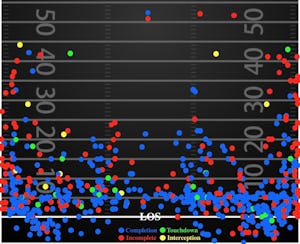
Splash plays
When you follow the defense, you are following some trends. But you are also trying to identify weak links and strong links. This is why I have been following "splash plays" for several seasons now. They are the same concept as helmet awards have been in the college ranks, as we try to track those players on defense who do something on a given play to make a real, tangible difference in stopping a play, and by extension, a drive.
What is a splash play? I tried to define it a while back as the following: A sack, a pressure that forces a bad throw, and big hit on the quarterback, and a batted ball that may lead to an interception opportunity. Again, you can see how this leads to subjectivity, but a subjective breakdown is better than no breakdown at all. In addition, a splash play will include tackles for loss, a big hit for a short gain or a stop, which is an open-field tackle where a player is pulled down on third down short of the marker because of an exceptional effort from a defender. A player who makes the opponent commit a holding penalty is a splash. An interception is clearly a splash play, but so is a defended pass that required a great effort. A major hit in the secondary could be a splash play, but I believe that the outcome of the play will determine that. Sorry, defensive backs, but standing over a guy who just caught a 15-yard pass because you think you hit him hard will not generally pass the test on this blog. So, stop doing it.
Here are the team totals since I have been doing this study (2011-present):
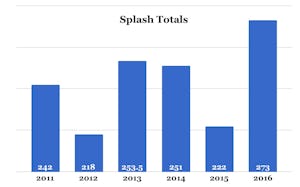
So, basically, somewhere between about 13 and 17 splashes per game are averaged over the six seasons of giving out these individual honors. We really want to find out who is responsible for certain good things. I am asked about doing the opposite for bad plays, but it is more difficult to always assign blame. Usually, there is no doubt who stops a play -- but not always about who helped. It is not a perfect system.
Annual splash leaders

Splash rate is how many snaps it takes for you to get a splash play. As you can see, David Irving in 2016 set the world on fire. I know in traditional stats, some saw 12 tackles and four sacks and wondered how that could get you to 27.5 splash plays. Well, consider he had five tackles for loss, four forced fumbles, batted down five passes at the line, recovered a fumble and generated 15 hurries. He was magnificent, and the best player on the field in at least a few games. I really hate that he was suspended for the first four games of this season because I think he is ready to be a superstar soon at the age of 24 (turned 24 last month) if he can keep his off-the-field life in order.
2016 splash standings
.jpg?q=50&auto=format&w=300)
As you can see, there are a lot of red lines crossed through names that contributed something last season. The Cowboys have a talented crew, but they need to replace quite a bit. Maliek Collins is about to head up this list.








No comments:
Post a Comment